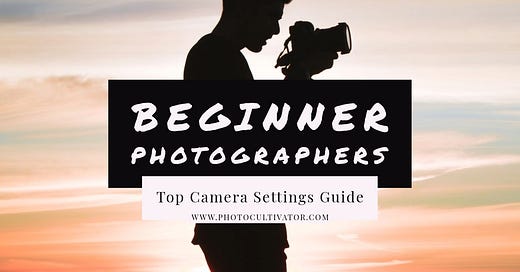Top Camera Settings Every Beginner Should Know
When you're just starting out in photography, all the different camera settings can seem really confusing and hard to understand.
But learning a few basic, important settings will help make your photos look a whole lot better and make taking pictures more enjoyable overall.
These key settings are super important to get familiar with:
1. Image Quality: Shoot in RAW
Most cameras allow you to shoot in RAW format, which captures more image data than JPEGs.
RAW files provide greater flexibility for post-processing and editing, allowing you to recover details in highlights and shadows, adjust white balance, and fine-tune other settings.
If you're new to photography and wondering which camera to start with, check out my guide on the best cameras for beginners to learn photography.
2. Focus Mode: Nail the Focus
Understanding and selecting the right focus mode is key for sharp images.
Most cameras offer the following focus modes:
Single AF (AF-S): Best for still subjects. The camera locks focus once you press the shutter button halfway.
Continuous AF (AF-C): Ideal for moving subjects. The camera continuously adjusts focus as the subject moves.
For a comprehensive overview of photography basics, including focus techniques, take a look at my ultimate photography guide for beginners.
3. Focus Area: Precise Focus Control
The focus area setting determines where in the frame the camera will focus.
Common options include:
Single Point AF: Allows you to select a specific focus point, giving you precise control over what's in focus.
Dynamic/Auto Area AF: The camera automatically selects the focus point(s), useful for moving subjects.
4. White Balance: Accurate Color Rendition
White balance ensures that colors in your images are accurately represented.
Most cameras have an Auto White Balance mode, which works well in many situations.
However, you can also select specific presets like Daylight, Cloudy, or Shade for better color accuracy in different lighting conditions.
5. Picture Style/Profile: Customize the Look
Many cameras allow you to adjust the look of your images straight out of the camera by changing the Picture Style or Profile settings.
These settings control parameters like contrast, saturation, and sharpness, enabling you to achieve a specific look or match your creative vision.
If you're still deciding which type of camera is right for you, my 2024 Camera Guide: DSLR vs. Mirrorless vs. Point-and-Shoot can help you make an informed decision.
Tips for Navigating Camera Settings
Start simple
Focus on understanding and adjusting the essential settings first.
Customize the Quick Menu
Add frequently used settings to the Quick Menu for easy access.
Use the camera's built-in help
Most cameras have a built-in help guide that explains various settings.
Leave unfamiliar settings on default
Don't change settings you don't understand yet.
Experiment and practice
Take test shots and experiment with different settings to see their effects.
For more tips on getting started with photography, check out the best photography courses and books for beginners.
And That’s It
Mastering these essential camera settings will give you more control over your images and help you capture better photos.
The key is to start simple, practice regularly, and gradually explore more advanced settings as you gain confidence.
If you're looking to improve your skills further, consider exploring my guides on vlogging tips for beginners or essential camera settings for beginners.
I hope that helps,
Let me know if you have any questions.
-Hakan.



